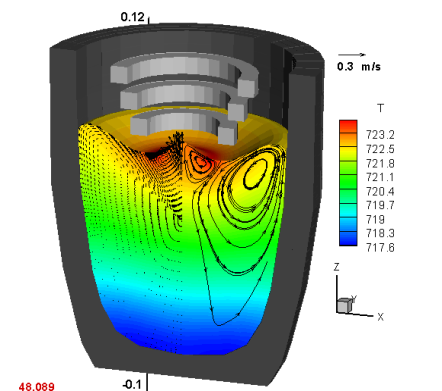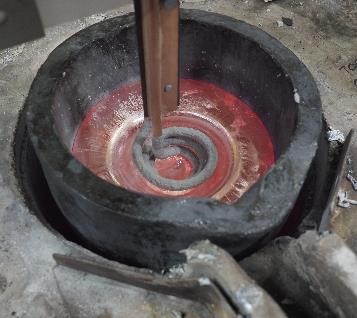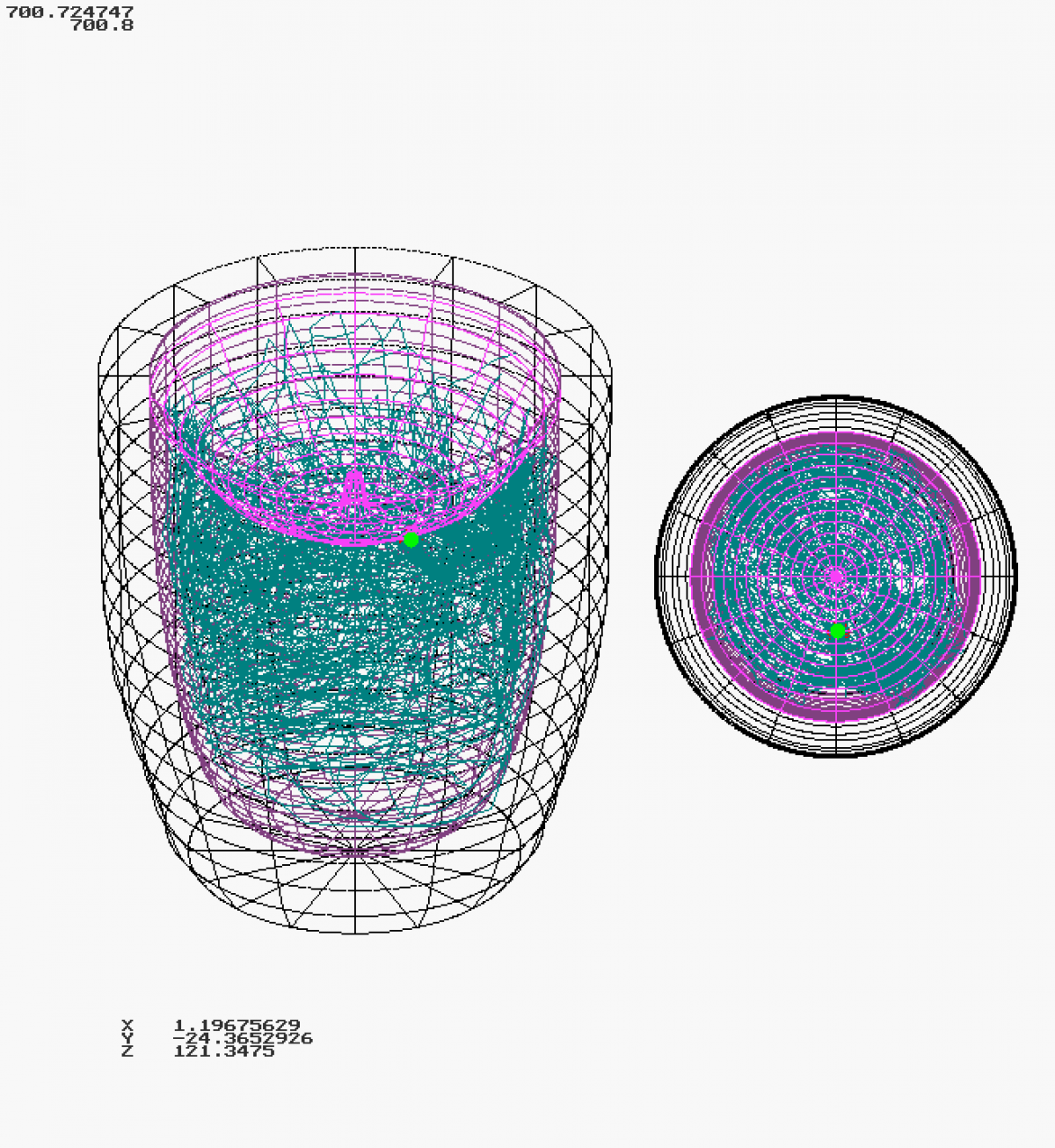Top Coil is an EPSRC funded collaborative project investigating the use of an electromagnetic coil positioned above a metal alloy melt to induce ultrasonic cavitation. The project combines expertise in numerical modelling from the University of Greenwich with experimental know how partners at the universities of Birmingham and Oxford. The project will use state of the art multi-physics modelling techniques combined with experiments on both crucible and continuous casting. The aims of the project are to investigate the top coils use in both ultrasonic treatment and in the distribution of both oxides and nano-particles within the melt in the production of composites. Positron Emission Particle Tracking (PEPT) will be used to track the motion of these particles.
TECHNOLOGY
In the quest for lighter, stronger metals for the transport and aerospace industry we aim in this research to develop and evaluate a contactless electromagnetic excitation device producing vibration in liquid metal melts, for the purpose of Ultrasonic treatment (UST). UST of light alloy metals (aluminium or magnesium) at the liquid state, has been shown to improve their final mechanical properties, leading to finer microstructure, removal of dissolved gases, or dispersion of strengthening particles. 
A 'sonotrode' probe immersed in the melt is commonly used for this UST process, vibrating at ultrasonic frequency (~20-100 kHz) and generating intense sound waves in the molten metal. These pressure waves cause dissolved gas to come out of solution in the form of micro-bubbles (think of champagne), then oscillate in size and either implode generating high speed jets and shock waves or enlarge to the point where they float to the surface and out of the melt. This cavitation phenomenon assists crystal nucleation and/or breaks up emerging dendritic crystals to reduce grain size and so improve material properties. Strengthening particles in the form of oxides are used in metal composites to improve their properties. However, it is difficult to disperse these particles evenly, ensuring homogeneous performance in the final component. Furthermore, very small particles tend to cluster together becoming defects. The action of shock waves produced by collapsing bubbles is known to break up particle clusters, but then strong stirring is also needed to disperse them evenly. The same particle dispersion requirement is needed in  aluminium recycling, to disperse unwanted inclusions, such as oxides or ferritic intermetallic particles.
aluminium recycling, to disperse unwanted inclusions, such as oxides or ferritic intermetallic particles.
So UST is potentially a very useful process, but even in low temperature melts (Al, Mg), there are problems preventing widespread use by industry: the immersed probe is consumed contaminating the melt; the mass treated is restricted to a small volume surrounding the sonotrode horn, and further mechanical stirring is then necessary to spread the effect. Contactless UST as proposed here will avoid contamination and the cost of exotic probe materials, transferring the potential benefits of UST to a wider range of alloys, avoiding most of the drawbacks: (a) Bulk stirring is automatically generated by the electromagnetic 'Lorentz' force, (b) Scale-up is easy, since the induction coil can be designed to fit the application, provided the supply frequency is tuned to promote resonance, (c) Since there is no contact, there is no contamination of the melt, or need for a frequent probe replacement and finally (d) high temperature or reactive metals used in power or aeroengine applications can be treated in the same way (viz. nuclear steels, nickel and titanium alloy blades)
The patented 'Contactless Sonotrode' concept originated from theoretical work and computer simulations carried out in Greenwich; but to translate its immense theoretical potential into a useful manufacturing technique, careful practical validation is needed through the proposed experimental programme at Birmingham and Oxford Universities. A prototype installation at Birmingham will investigate light alloys, steel and nickel in crucible melts, whilst Oxford will test the idea in the Direct Chill (DC) continuous casting process for aluminium ingot production.
OBJECTIVES
This research will be of immediate benefit to the aluminium industry allowing the early implementation of the technique to the treatment of melts in crucibles prior to casting as a direct replacement of the immersed sonotrode method. Advantages over the existing technique will be the lack of melt contamination, concurrent melt stirring and positive energy contribution due to induction heating and reduced maintenance. Scale-up potential and adaptability to application are also important advantages for industrial applications.

The DC casting implementation with a top coil sonotrode will lead to rethinking of the existing process, with the additional heating provided by the coil and potential to control the flowfield within the DC sump. The possible elimination of grain refiner in the production of ingots will reduce costs and ease recycling. Several commercial companies expressed interest in this implementation (e.g. SAPA, KBM, Foseco), for adoption following proof of concept.
Implementation in reactive materials offers the potential for grain refinement in TiAl and Ni superalloy turbine blades, for the aero-engine and industrial gas turbine industry, with particular interest from Rolls-Royce. The excellent high temperature facilities recently established in Birmingham University plus the existing vacuum chamber used previously in joint Birmingham-Greenwich research will be considered to demonstrate the applicability of the method in protected atmospheres.
Titanium nitrides are a source of defects in titanium components used in aerospace, or in biomedical implant applications. Degassing of reactive titanium melts through contactless ultrasonic treatment offers the future possibility of reducing the problem by extracting nitrogen from the melt, especially important in titanium recycling.
Steel grain refinement due to UST is well known, but rarely used faced with the difficulty of application to industry due to the high temperature of the melt. The potential of a cylindrical induction coil surrounding a pouring sprue and tuned to excite resonant sound waves will be demonstrated as a realistic implementation. The addition of nano-particles or oxides, will demonstrate the benefits of contactless UST as a replacement for the expensive powder route for the manufacture of ODS steel components needed by the nuclear industry.
Finally, the emerging area of metal-matrix composites is a realistic impact area, with focused ultrasonic energy targeting immersed particle clusters for de-agglomeration and uniform dispersion in the liquid metal. Again, the transport and aerospace industries will be the main targets here. There is already have a strong network of industrial contacts formed in the recent ExoMet EU project that will be targeted for future commercial exploitation
Wider dissemination to industry and academic audiences will be through planned attendance in international conferences by all partners and demonstrations of the technique to industry and a planned high profile exhibition at TMS towards the end of the project.
